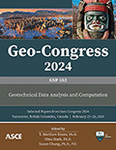Applicability of MCC and CASM-Based Structured Soil Models
Publication: Geo-Congress 2024
ABSTRACT
In situ soils generally exhibit a structure due to bonding that exists between the soil constituents. The behaviour of the structured clay is different from the reconstituted clay which needs to be modelled accurately. This study aims to understand the accuracy and reliability of two different phenomenological models based on the critical state framework formulated to predict the behaviour of structured clay. These models (Lee and CASM-n) are calibrated with drained conventional triaxial experiments for two different percentages of cement content (high and low cement content) after obtaining the material parameters. A non-linear optimization technique is used to obtain other model-fitting parameters. After obtaining the parameters, a single-element explicit integration scheme is used to simulate the drained triaxial test for different confining pressures. The Lee model predictions deviate from the experimental results for the materials that exhibit a dominant frictional response, such as that exhibited by low-cemented clays, but predicted the behaviour of cohesion dominant response as observed for high-cemented clays reasonably well. However, CASM-n model was able to predict the behaviour of low-cemented clays accurately.
Get full access to this article
View all available purchase options and get full access to this chapter.
REFERENCES
Consoli, N. C., Rotta, G. V., and Prietto, P. D. M. (2000). ‘Influence of curing under stress on the triaxial response of cemented soils’, Geotechnique, 50(1), pp. 99–105. Available at: https://doi.org/10.1680/geot.2000.50.1.99.
Hashiguchi, K. (1989). ‘Subloading surface model in unconventional plasticity’, International Journal of Solids and Structures, 25(8), pp. 917–945. Available at: https://doi.org/10.1016/0020-7683(89)90038-3.
Lee, K., Chan, D., and Lam, K. (2004). ‘Constitutive model for cement treated clay in a critical state frame work’, Soils and Foundations, 44(3), pp. 69–77. Available at: https://doi.org/10.3208/sandf.44.3_69.
Liu, M. D., and Carter, J. P. (2002). ‘A structured Cam Clay model’, Canadian Geotechnical Journal, 39(6), pp. 1313–1332. Available at: https://doi.org/10.1139/t02-069.
Nguyen, L. (2016). Developing constitutive model to simulate behaviour of cement treated clay composite capturing effect of cementation degradation, (July).
Roscoe, K. H., Schofield, A. N., and Wroth, C. P. (1958). ‘On the yielding of soils’, Geotechnique, 8(1), pp. 22–53. Available at: https://doi.org/10.1680/geot.1958.8.1.22.
Suebsuk, J., Horpibulsuk, S., and Liu, M. D. (2010). ‘Modified Structured Cam Clay: A generalised critical state model for destructured, naturally structured and artificially structured clays’, Computers and Geotechnics, 37(7–8), pp. 956–968. Available at: https://doi.org/10.1016/j.compgeo.2010.08.002.
Yu, H. S. (1998). ‘CASM: a unified state parameter model for clay and sand’, International Journal for Numerical and Analytical Methods in Geomechanics, 22(8), pp. 621–653. Available at: https://doi.org/10.1002/(SICI)1096-9853(199808)22:8%3C621::AID-NAG937%3E3.0.CO;2-8.
Yu, H. S., Tan, S. M., and Schnaid, F. (2007). ‘A critical state framework for modelling bonded geomaterials’, Geomechanics and Geoengineering, 2(1), pp. 61–74. Available at: https://doi.org/10.1080/17486020601164275.
Information & Authors
Information
Published In
History
Published online: Feb 22, 2024
ASCE Technical Topics:
- Clays
- Design (by type)
- Engineering fundamentals
- Geomechanics
- Geotechnical engineering
- Mathematics
- Model accuracy
- Models (by type)
- Parameters (statistics)
- Soil mechanics
- Soil properties
- Soil structures
- Soils (by type)
- Statistics
- Structural behavior
- Structural design
- Structural engineering
- Structural models
- Structural reliability
- Structures (by type)
Authors
Metrics & Citations
Metrics
Citations
Download citation
If you have the appropriate software installed, you can download article citation data to the citation manager of your choice. Simply select your manager software from the list below and click Download.
